During the Ming Dynasty, Taoists posited the existence of the 'gods of flowers'. In the mid Qing Dynasty, there appeared 'flower gods' series among Yangliuqing New Year pictures, in which characters from Tang and Song legends and historical figures are identified as the gods/goddesses of flowers. The flower gods/goddesses of twelve months have been designated according to social customs and the natural cycle of flowers. The list is influenced more by people’s subjective consciousness than that of flowers of the twelve months, with a rich variety of opinions and greater differences between them. Two of the most popular lists are: Princess Shou, goddess of plum blossom for the first lunar month; Yang Yuhuan, goddess of apricot blossom for the second; Lady Xi, goddess of peach blossom for the third; Lijuan, goddess of peony for the fourth; Wei Shi, goddess of pomegranate blossom for the fifth; Xi Shi, goddess of lotus flower for the sixth; Lady Li, goddess of sunflower for the seventh; Virtuous Concubine Xu, goddess of sweet osmanthus for the eighth; Imperial Concubine Zuo, goddess of chrysanthemum for the ninth; Lady Huarui, goddess of cotton rose for the tenth; Wang Zhaojun, goddess of camellia for the eleventh; and Goddess of the Luo River, goddess of daffodil for the twelfth; Qu Yuan, god of orchid for the first lunar month; Lin Bu, god of plum blossom for the second; Pi Rixiu, god of peach blossom for the third; Ouyang Xiu, god of peony for the fourth; Su Dongpo, god of Chinese peony for the fifth; Jiang Yan, god of pomegranate blossom for the sixth; Zhou Dunyi, god of lotus flower for the seventh; Yang Wanli, god of crape myrtle for the eighth; Hong Shi, god of sweet osmanthus for the ninth; Fan Chengda, god of cotton rose for the tenth; Tao Yuanming, god of chrysanthemum for the eleventh; and Gao Sisun, god of daffodil for the twelfth.
Apart from these two lists, in which all the twelve flowers are represented by either gods or goddesses, there is a list in which there are gods (Yang) for the odd-number months and goddesses (Yin) for the even-number ones: Liu Mengmei, god of plum blossom, for the first lunar month; Yang Yuhuan, goddess of apricot blossom, for the second; Yang Yanzhao, god of peach blossom, for the third; Zhang Lihua, goddess of multiflora rose, for the fourth; Zhong Kui, god of pomegranate blossom, for the fifth; Xi Shi, goddess of lotus flower, for the sixth; Shi Chong, god of garden balsam, for the seventh; Lüzhu, goddess of sweet osmanthus, for the eighth; Tao Yuanming, god of chrysanthemum, for the ninth; Xie Suqiu, goddess of cotton rose, for the tenth; Bai Letian, god of camellia, for the eleventh; and Lao Ling Po (She Taijun), goddess of Japanese allspice, for the twelfth. This list, in which each character is associated with a historical story, is more consistent with the Taoist pursuit of the union of Yin and Yang and the unity of human and nature.

According to available records, polychrome cups with design of flowers of twelve months were made in batches in Jingdezhen during Kangxi’s reign. Apart from several sets collected in the Palace Museum in Beijing, some were given to local museums in the 1950s and the 1980s. Because of their preciousness, there have also appeared many imitations. Some were produced during Emperor Yongzheng’s reign. However, few of these still exist in sets. During Emperor Qianlong’s reign, there were only cups with design of plum blossoms or orchids, most of which were made separately and rarely in sets. In Jiaqing and Daoguang’s reigns, there were Fencai (famille rose) cups with design of flowers of twelve months, but they were large and coarse (Fig. 15). The Republic of China period saw an increase in imitation polychrome cups with design of flowers of twelve months (Fig. 16), the workmanship of which is fairly good but still inferior to Kangxi cups in many ways. Specifically, the bodies of the former are fine and white but not quite compact, so that they feel lighter than the latter if weighed by hand; their glaze is white and smooth but loosely attached to the body, with no raised rim; in terms of the form, the connection of straight lines and curves is not smooth enough and the overall form seems quite fragile. A more obvious difference lies in the base, which has a curved rather than right-angle edge, so that the cup is easy to slip off one's hand. Moreover, the patterns on cups made in the Republic of China period are not so finely painted as those on Kangxi cups, and lack embellishment for details.
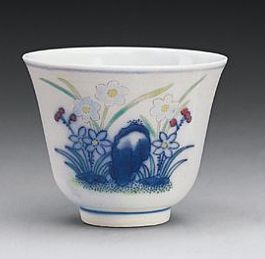
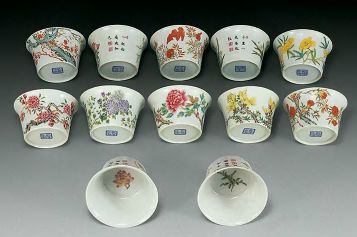
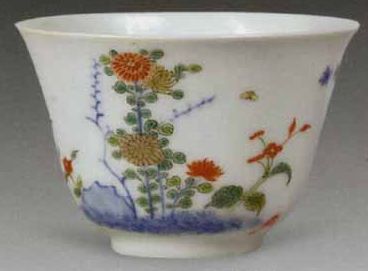
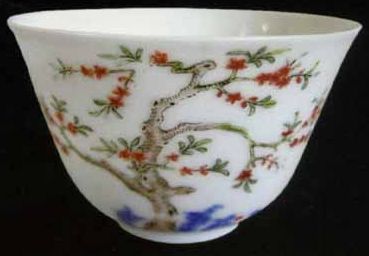
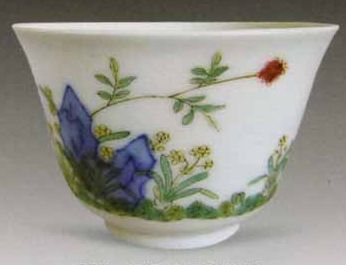
The twelve cups was probably related to the compilation of The Complete Tang Poems during Kangxi’s reign, the publication of Guang Fang Qun Pu, a book on agronomic botany, and the peaking of ceramic production at government kilns in that period. In 1705 (the 44th year of Kangxi’s reign), Peng Dingqiu, Shen Sanzeng and Zhong Ne compiled The Complete Tang Poems by imperial order. Based on Tang Yin Tong Qian by Hu Zhenheng of the Ming Dynasty and Tang Poems by Ji Zhenyi of the early Qing Dynasty, this unprecedented collection contains more than 48,900 Tang poems by over 2,200 authors. In 1708 (the 47th year of Kangxi’s reign), Liu Hao and others compiled Guang Fang Qun Pu (Expanded Compendium of Flowers) by imperial order, which was an extended edition of Qun Fang Pu (Compendium of Flowers) by Wang Xiangjin of the Ming Dynasty. Divided into 100 volumes, the book is mostly about the cultivation of plants for practical purposes. In particular, in the part about flowers, the descriptions of their characteristics are accompanied by related literary works of past ages, including biographies, inscriptions and poems. These two books formed the theoretical basis for the twelve cups with flower design. In fact, the poetic lines on ten of them can be found in The Complete Tang Poems.
In terms of firing porcelain in Jingdezhen during the Qing Dynasty, Kangxi government kilns reached the first peak at Zang Kiln under the supervision of Zang Yingxuan from 1683 to 1688 (22nd-27th year of Kangxi’s reign). The porcelain production of this kiln, however, only lasted a short period of time. Records show that it achieved the highest level in the diversification of glaze colors but made no innovation in form. From 1795 to 1712 (44th-51st year of Kangxi’s reign), when Lang Tingji was appointed governor of Jiangxi and concurrently supervisor of ceramics production, he brought the production at Kangxi government kilns to its summit with the fruitful innovation of new varieties in diverse styles based on traditions. In particular, the successful production of imitation Chenghua blue-and-white porcelain and white-glazed Tuotai (bodiless) porcelain laid the technical foundation for the twelve cups with flower design, which are masterpieces among thin-body porcelain. The most noteworthy fact is that Lang Tingji was not only devoted to porcelain production but also an expert on wine culture. His Sheng Yin Ge and Shen Yin Pian contain detailed accounts about Jiuchou (chip on which tallies are recording during a drinking game), Jiuling (drinkers' forfeit game), and the twenty-eight favorable circumstances for drinking that were universally acknowledged from a traditional perspective. Thus the successful production of the twelve cups with flower design was the result of the publication of The Complete Tang Poems and Guang Fang Qun Pu, which coincided with the supervision of the government kiln in Jingdezhen by Lang Tingji, who was well-versed in both porcelain production and wine culture.
The polychrome cups with design of flowers of twelve months are also known as the cups of flower gods/goddesses of twelve months. The flower on each cup corresponds to a particular month and one of twelve famous historical figures, who is the god/goddess in charge of that flower.
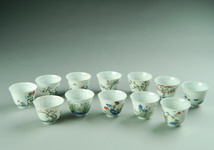
The Kangxi cups with design of flowers of twelve months start from the daffodil, which is followed by the magnolia, the peach blossom, the peony, the pomegranate blossom, the lotus flower, the orchid, the sweet osmanthus, the chrysanthemum, the cotton rose, the Chinese rose, and the plum blossom.
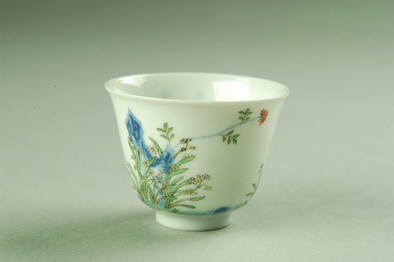
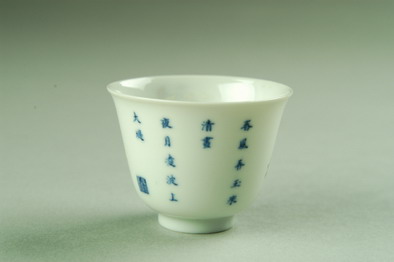
The daffodil cup (Fig. 2) features a daffodil and mountain rocks, beside which are two poetic lines--'An elegant picture of jade fondled by spring breeze/Ripples on the great dyke in moonlight'.
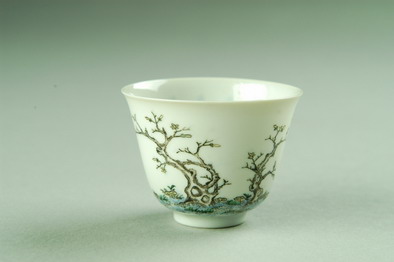
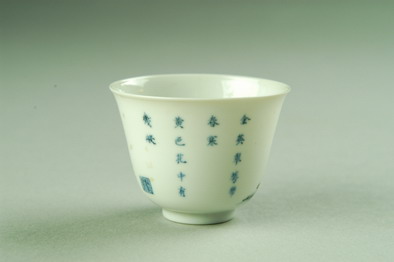
The magnolia cup (Fig. 3), also known as the winter jasmine cup, features a magnolia tree, beside which are two lines from a poem by Bai Juyi--'Golden blossoms and green calyx in the spring cold/How many like these can you find among yellow flowers'.
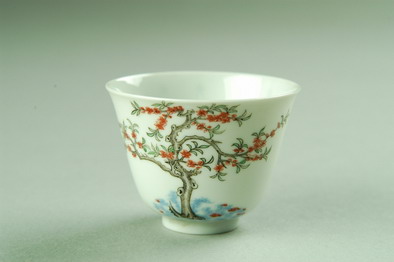
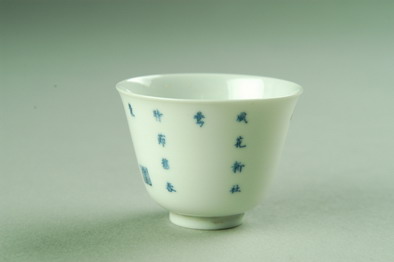
The peach blossom cup (Fig. 4) features an old and vigorous peach tree, with two lines from ‘Peach Blossoms' by Tang poet Xue Neng--'They attract new swallows/In the prime of springtime'.
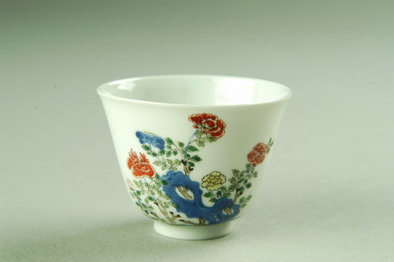
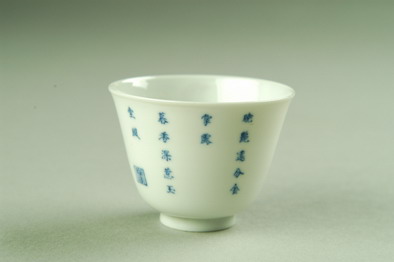
The peony cup (Fig. 5) features a peony in full bloom, with two lines from 'Peony' by Han Cong--'Her morning splendor is set off by dewdrops/And her evening scent is wafted by wind through jade halls'.
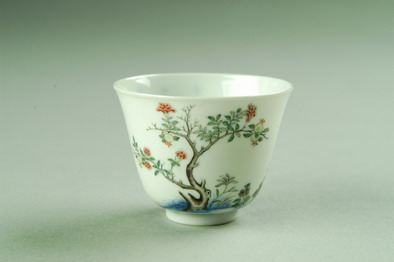
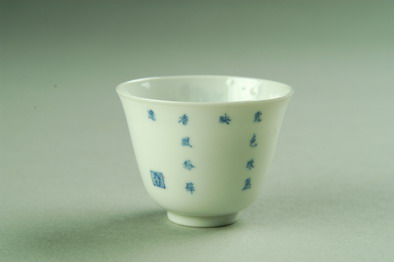
The pomegranate blossom cup (Fig. 6) features a pomegranate tree with a dark brown trunk, beside which are two lines from one of the two poems on pomegranate blossoms by Sun Ti--'The color is reflected on the bead curtain/And the scented wind is screened by a white wall'.
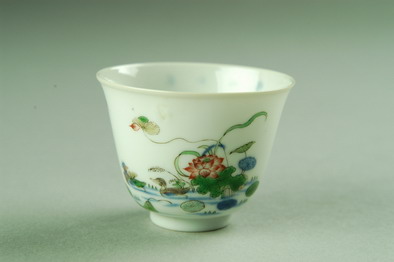
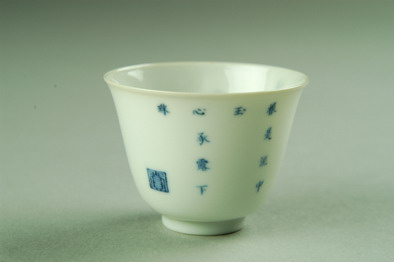
The lotus flower cup (Fig. 7) features a lotus flower, with two lines from 'Lotus Leaves' by Tang poet Li Qunyu--'She strikes jade-like root into the mud/And holds dewdrops in her heart'.
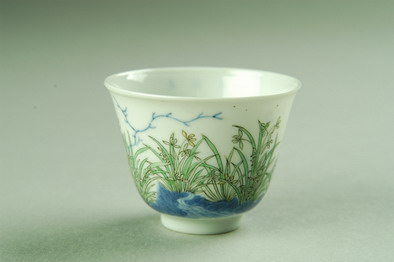
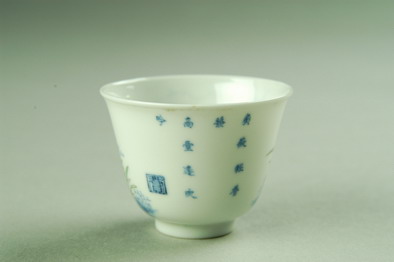
The orchid cup (Fig. 8) features an orchid, with two lines from 'Orchid' by Li Qiao--'From a great elevated hall/The delicate scent is wafted far away'.
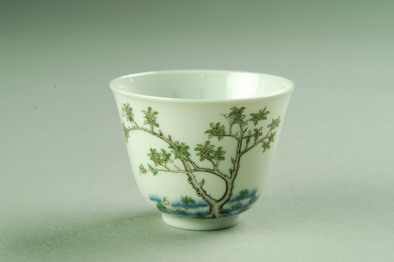
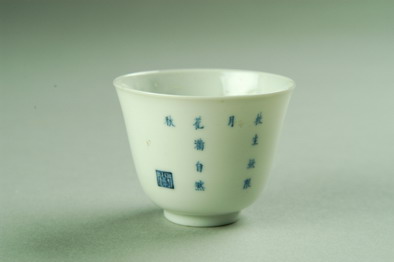
The sweet osmanthus cup (Fig. 9) features a bough from a sweet osmanthus tree, with two lines from 'Sweet Osmanthus' by Li Qiao--'The boughs catch boundless moonlight/And the thriving blossoms announce the arrival of autumn'.
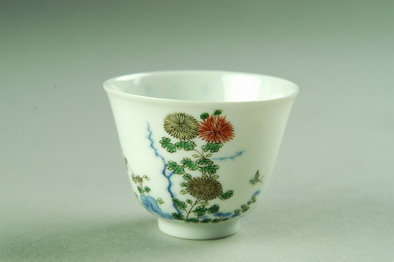
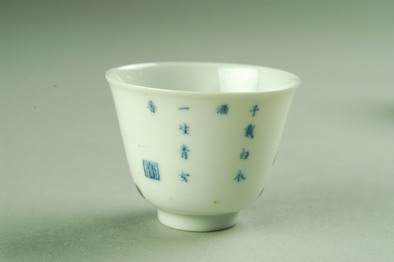
The chrysanthemum cup (Fig. 10) features a chrysanthemum, with two lines from 'Chrysanthemum' by Tang poet Luo Yin--'Her enduring scent reminds me/Of the white man who brought wine to Tao Yuanming'.
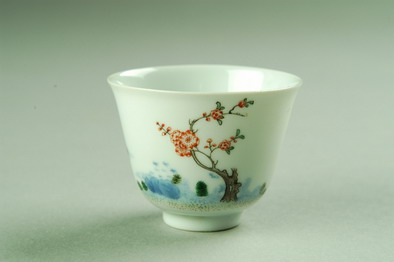
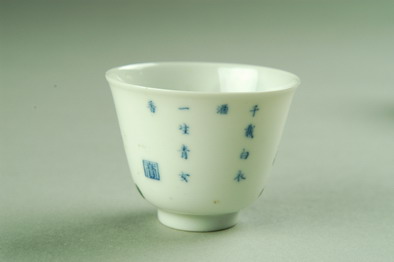
The cotton rose cup (Fig. 11) features a cotton rose, with two lines from a poem by Qian Qi--'The delicate scent has blended with the night rain/And the charming features now stand out in the mist'.
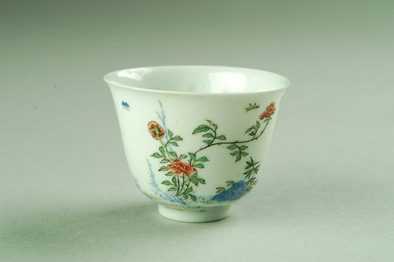
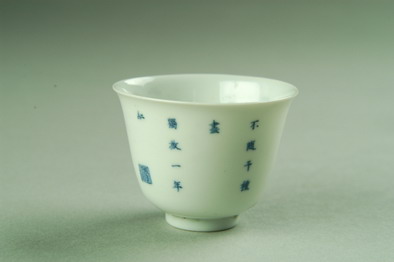
The Chinese rose cup (Fig. 12) features a Chinese rose, with two poetic lines--'While all other flowers have faded/She still blossoms till the end of the year'.
The twelve cups made in Emperor Kangxi’s reign boast elegant colors, smooth and sparkling glaze, and paper-thin bodies, which are light, translucent and lustrous with almost invisible matrixes. They are indeed masterpieces that integrate ceramic techniques, painting, calligraphy, poetry and seal-cutting art.
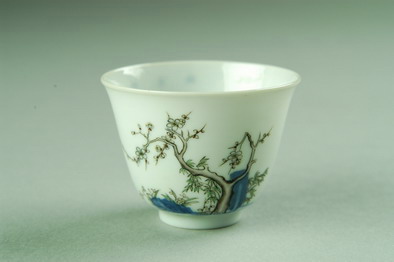
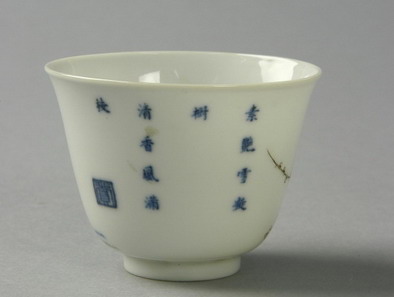
The plum blossom cup (Fig. 13) features plum blossoms, with two lines from a poem by Xu Hun--'A tree laden by snow-like blossoms/And pervaded by a delicate scent'.
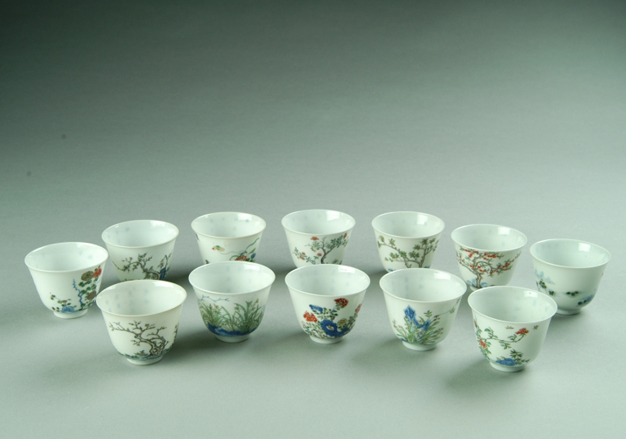
Period:
Emperor Kangxi’s reign of the Qing Dynasty.
Measurement:
Mouth diameter 6.60 cm, height 5.00 cm, base diameter 2.7 cm.
Acquisition:
Given by the Palace Museum in 1958. Currently collected in Henan Museum.
Each cup has a flared lip, a deep belly and a ring base, with a thin and fine body, fresh and elegant color, and white glaze. The twelve cups are adorned on the exterior with polychrome motifs of daffodil, magnolia, peach blossom, peony, pomegranate blossom, lotus flower, orchid, sweet osmanthus, chrysanthemum, cotton rose, Chinese rose, and plum blossom respectively, which are set off by Wuyan or Qiyan poems. Each cup features one kind of flower and one poem, which ends with a seal bearing the word Shang (appreciation). Within the ring base are blue characters Da Qing Kang Xi Nian Zhi (made in Emperor Kangxi’s reign of Great Qing) in regular script.